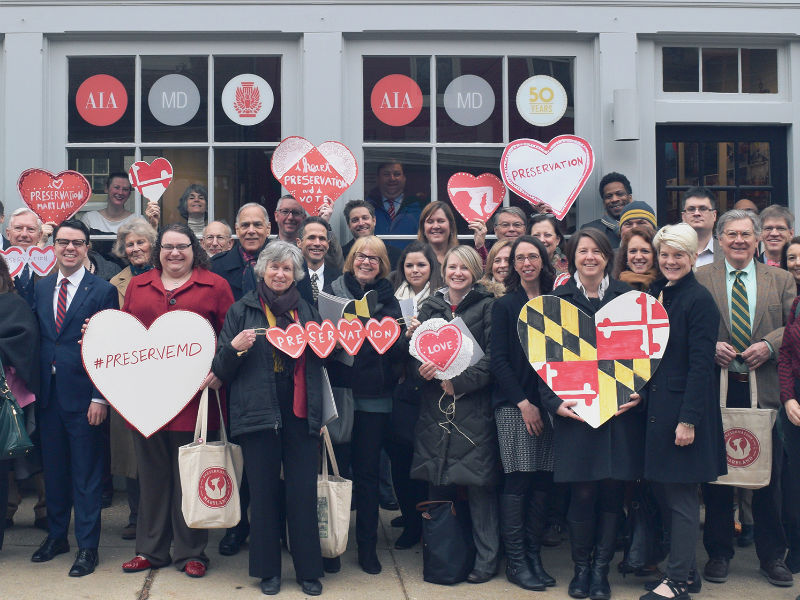When Preservation Maryland was formed in 1931, nearly 90 years ago, the United States was in a period of dramatic transformation. The pre-war twentieth century and the decades which followed World War Two were also remarkably focused on the future – and the history and heritage which stood in the way was simply brushed aside.
This era saw the whole-scale demolition of neighborhoods in the name of “urban renewal” and the construction of an expansive interstate highway system. The federal and state governments paid little attention to the concerns of preservationists. It was an uphill struggle – it always has been and, perhaps, always will be.
However, what has changed in the intervening years has been an installation of a preservation ethic across society that was nonexistent during our formative years. This ethic may not always prevail – but it is strong and ever present.
In just the past few weeks, we’ve seen signs of it around every corner:
- The National Trust for Historic Preservation used their America’s 11 Most Endangered List to shine a light on long-term on-going local efforts to preserve George Washington’s view from Mount Vernon across the Potomac to Maryland and issues of sea level rise and questionable re-zoning proposals along Annapolis’ historic waterfront. Immediately, coalitions from Virginia and Maryland came together in cooperation with a regional and unified response that they will not stand idly by when our most historic resources are threatened.
- In Ellicott City, elected officials in state and local government have decried those voices calling to “abandon” the historic town – making the case that the history and heritage of this place must be preserved for future generations and recognizing the economic value of places like Ellicott City. Contrast that stance with Howard County officials who required much persuading in the 1970s to list this place on the National Register and whose initial inclination was to demolish resources standing in the way of new roads or infrastructure.
- In Hagerstown, as a part of a broader political event, Governor Hogan made much ado about the restoration of the historic Maryland Theater and announcing a massive state subsidy to support the project – itself part of a much larger urban revitalization project that hinges on reuse and rehabilitation instead of the tired urban renewal demolition schemes of the past century. Perhaps it should come as no surprise then, that the good politics of this announcement came on the same weekend the governor officially launched his reelection bid.
- In Cambridge and Baltimore – the preservation ethic arose to “fight the good fight” when proposals to demolish character defining structures in those venerable cities became public. In Cambridge, the non-profit Eastern Shore Land Conservancy joined with a private developer to push back against the knee-jerk “demolish-first-and-ask-questions-later” plan of the City of Cambridge; a preservation battle still being played out. In Baltimore, when plans to demolish two stone cottages in the historic Woodberry neighborhood became public, neighbors, preservationists and community leaders voiced their opposition and rallied media coverage of the issue in less than 24 hours.
- The Maryland League of Conservation Voters released their Vision 2025 Voter Guide – and in it make the case for the expansion of the state historic tax credit which they note, “revitalize[s] older communities and incentivize[s] revitalization of existing communities over continuing patterns of ruinous sprawl…” thus connecting the environmental movement with preservation in a way that preservationists could have only dreamed just a generation ago.
Success in every situation is far from assured – but what is clear is that a preservation ethic has most assuredly taken hold. Once enshrined in the hearts of the people, that ethic is sure to win over the long haul and though there may be losses, we simply can’t lose when the majority favors preservation over demolition and neglect.
The preservation ethic isn’t just anecdotally recognized – recent polling here in Maryland has underscored that the vast majority of Marylanders support increased funding and tools to protect historic resources. Preservationists are the majority. From Oakland to Ocean City, the numbers are the same and equally impressive.
For those in the trenches of preservation, it’s important to remember you are not alone and your fellow citizens are behind your efforts. As the statewide organization, with a near 90-year history, it’s also heartening to see the impact of our nine decades of preservation advocacy.
Historian Stephen Ambrose’s axiom continues to ring true:

